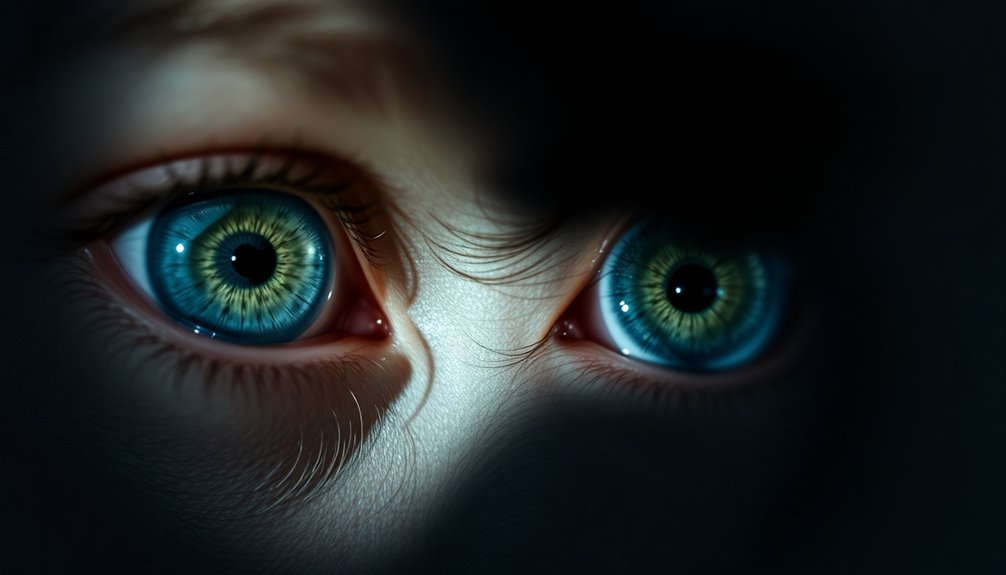Symbolism in poetry is an exciting way poets express deeper ideas through everyday images. It turns simple objects or actions into powerful symbols that can represent complex feelings, themes, or messages. For example, a heart can symbolize love, while a wilting flower might represent sadness or loss. When you spot symbolism, it helps you connect more with the poem and see different meanings. It invites you to think and feel along with the poet. Discovering these symbols can be like unearthing hidden treasures that make poetry even more special and engaging. There's so much more to uncover!
Key Takeaways
- Symbolism in poetry conveys deeper meanings beyond the literal, transforming images into significant representations of larger ideas.
- It enhances emotional depth, connecting readers to feelings and allowing for multiple interpretations of themes.
- Various types of symbols exist, including universal, cultural, personal, allegorical, and mythological symbols, each with unique meanings.
- Nature, colors, and objects often serve as symbols, evoking emotions and enriching the thematic resonance of the poem.
- Symbolism invites critical thinking and exploration of personal and societal issues, enhancing the overall reading experience.
Definition of Symbolism

Symbolism in poetry is all about using symbols to express deeper meanings that go beyond the literal. When poets use symbolism, they're transforming everyday images or objects into something much more significant. It's like a secret code!
You see, these symbols can represent larger ideas, making the poem richer and more engaging. Imagine reading a poem that mentions a rose. On the surface, it's just a flower, right? But it can symbolize love, beauty, or even passion. That's the magic of symbolism in poetry!
By understanding these symbols, you can discover multiple interpretations and feelings hidden within the text. Writers often choose common symbols that reflect universal themes, like love, death, or nature. This makes it easier for you, the reader, to connect emotionally.
However, keep in mind that the context matters! Cultural and personal experiences can shape how you understand these symbols.
Importance in Poetry
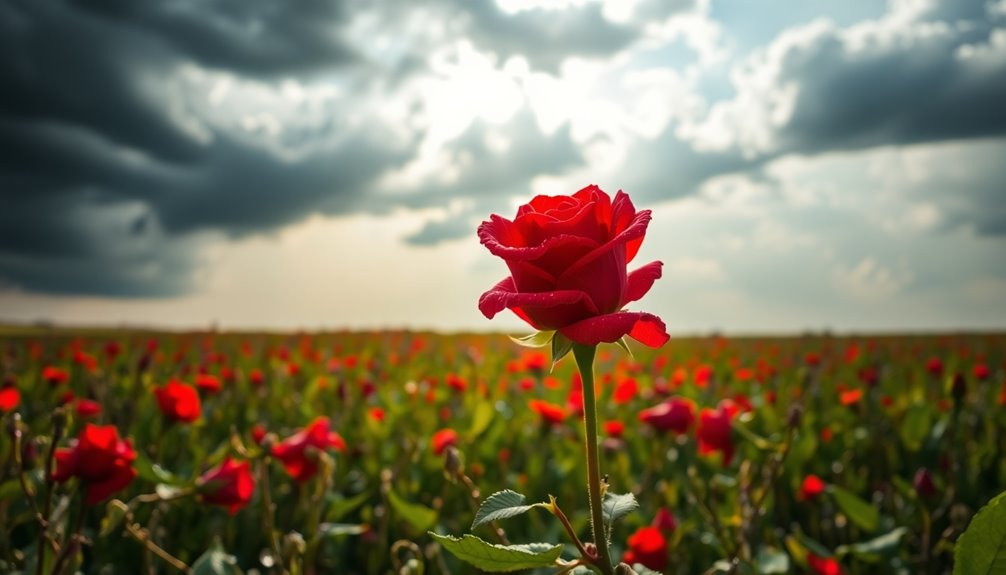
Symbolism is super important in poetry because it adds emotional depth and makes themes come alive!
When you see a symbol, it often connects to feelings and ideas that touch your heart.
Plus, it helps you think deeper about what the poet is trying to say, making your reading experience so much richer!
Emotional Depth in Poetry
Exploring the emotional depth in poetry reveals how poets can connect with readers on a profound level. When you read a poem, you might notice that symbols play an important role. These symbols can represent complex feelings and ideas through simple images. For example, a flower might symbolize love, while a storm could represent sadness. This use of symbols helps create emotional depth, allowing you to feel a strong connection with the poem.
As you dive deeper into the text, you might find that these symbols evoke specific emotions. This means that the imagery aligns with the poem's themes, leaving a lasting emotional resonance. You can interpret the symbols in your own way, making the poem personal and meaningful to you.
Poets often use nature, like seasons or weather, to reflect human emotions. This enriches the emotional landscape of their work. By using symbolism, poets can also explore personal struggles or social issues, inviting you to see beyond the literal words.
Enhancing Thematic Resonance
The power of imagery in poetry extends beyond emotional depth to enhance thematic resonance. When you read a poem, symbolism is often the bridge that connects complex ideas to concrete images. This makes abstract concepts easier for you to grasp. By using symbols, poets create layers of meaning, inviting you to engage with their work on multiple levels.
Take a look at this table to see how symbolism works:
| Symbolism Example | Thematic Connection |
|---|---|
| A broken mirror | Self-identity |
| A wilting flower | Loss |
| An open door | Opportunity |
| A stormy sky | Conflict |
| A rising sun | Hope |
These symbols can evoke strong emotions, helping you feel the mood and tone of the poem. They also connect personal experiences with universal truths, allowing you to find personal significance in the themes. When poets use this literary device effectively, they challenge your perceptions and encourage you to think critically about the themes presented. So, next time you read a poem, keep an eye out for the symbols that enhance its deeper meanings!
Types of Symbolism
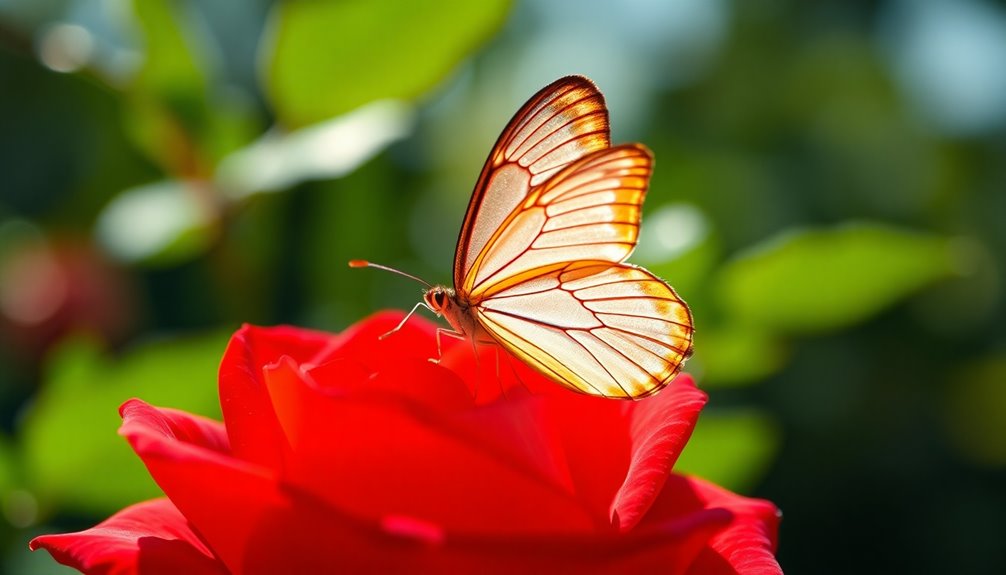
Let's explore the different types of symbolism in poetry!
You'll find that colors can spark emotions, like red for love or blue for calm.
There are also animals and everyday objects that carry special meanings, making poetry even more exciting and rich with layers to discover!
Color Symbolism Overview
Color symbolism enriches poetry by infusing emotions and ideas with deeper meaning, allowing readers to connect on multiple levels. Each color tells a story and evokes feelings that help you understand the poem better.
Take the color green, for instance. It often symbolizes nature, growth, and renewal. You can feel the freshness of spring and the excitement of new beginnings when you read about it. It invites you to think about life and the beautiful world around you.
On the other hand, black as a symbol can evoke strong emotions too. It often represents mystery, death, or the unknown. When you see black in a poem, it might make you feel a sense of fear or sorrow. This color adds depth to the themes and can make you ponder deeper meanings.
Colors like red, blue, and white also play unique roles in poems. Red can symbolize love or danger, while blue brings calmness. White often stands for purity and new beginnings. Each color adds a special touch, making poetry a colorful journey of emotions and ideas!
Animal Symbolism Examples
Exploring symbolism in poetry opens up a world where animals serve as powerful representations of various traits and themes. Animal symbolism can evoke strong emotions and connect you to human experiences. For example, a dove might represent peace, while a lion symbolizes strength and courage. Each animal carries its own meaning, often influenced by cultural backgrounds.
Here's a quick look at some common animal symbols in poetry:
| Animal | Symbolism |
|---|---|
| Butterfly | Transformation and change |
| Owl | Wisdom and knowledge |
| Fox | Cunning |
In addition, you might find that a turtle represents patience and wisdom, while a snake can symbolize both danger and healing. Poets use figurative language to paint vibrant images, bringing these animals to life in their verses. By understanding animal symbolism, you can dive deeper into the themes and feelings behind the words. So, the next time you read a poem, pay attention to the animals. You might discover a whole new layer of meaning waiting to be explored! Moreover, recognizing the importance of self-awareness can enhance your interpretation and appreciation of these symbols in poetry.
Common Object Symbolism
Common object symbolism enriches poetry by infusing everyday items with profound meanings. These symbols can transform simple objects into powerful messages. For example, a crown often represents power and authority, while chains can symbolize imprisonment and restriction. Isn't it fascinating how something so ordinary can say so much?
Cultural significance also plays a big role. A wedding ring, for instance, symbolizes eternal love and commitment. This reflects its importance in our lives and society.
In literature, using objects as symbols enhances themes and helps develop characters. It allows you to connect emotionally with the story.
Think about a rose—it's known as a symbol of love and beauty. On the other hand, a skull can represent mortality, reminding us of life's fragility. These examples of symbolism show how objects can carry deep meanings.
However, remember that symbols can change depending on the culture and context. What might mean one thing in one place can mean something different elsewhere.
Recognizing Symbolism
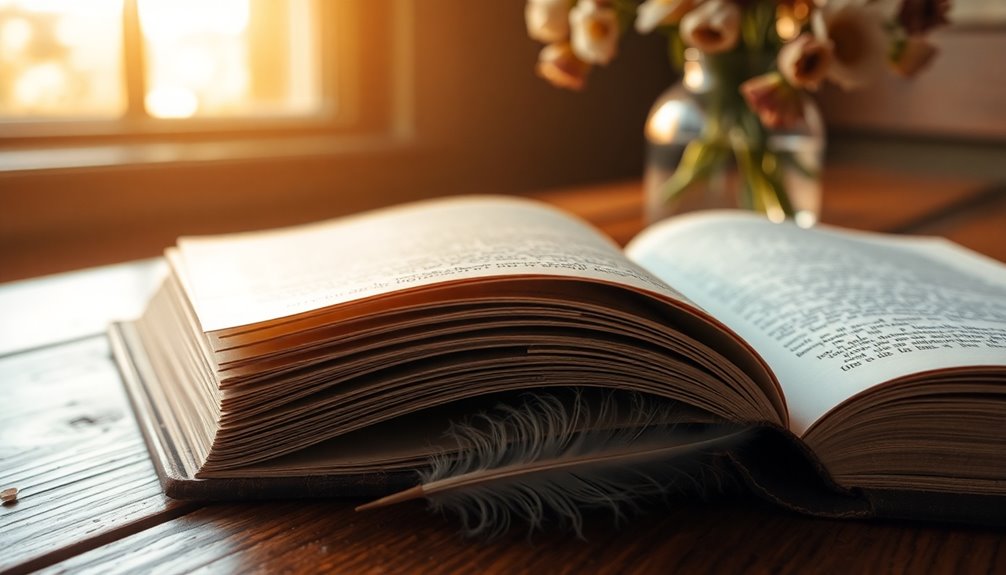
Recognizing symbolism in poetry is like uncovering hidden treasures within the text. When you read a poem, look for images or objects that suggest meanings beyond their literal interpretations. They can enrich the poem's themes and feelings.
To help in recognizing symbolism, pay attention to repeated images or motifs. Ask yourself what emotions these symbols might evoke and how they fit into the poem's context.
Some authors use clear symbols that are easy to spot, while others might hide them more subtly. Don't worry if you don't catch everything on your first read! Re-reading poetry can reveal layers of symbolism that become clearer as you get more familiar with the text.
Also, remember that cultural and historical contexts can shape how symbols are understood. It's important to know a bit about the background of both the poem and its symbols.
Analyzing Symbolism in Literature

Often, analyzing symbolism in literature reveals deeper layers of meaning that can transform your understanding of a text. When you look closely at symbols, like the well-known symbol of love, you uncover connections that make the story or poem richer.
Start by identifying recurring symbols and examining where they appear. Consider their historical and cultural significance—this can give you clues about the author's intentions.
Different types of symbolism can show you how symbols relate to the overall theme. For instance, a rose might represent not just love, but also beauty and passion. Pay attention to how these symbols affect characters and plot progression. They often highlight important moments that shape the story.
Don't forget to notice the emotional impact of certain symbols! They can evoke feelings that pull you deeper into the narrative. To truly grasp their meanings, multiple readings and discussions help a lot. Sometimes, your understanding can shift as you dive deeper.
Examples From Notable Poets

Poets frequently weave rich symbolism into their work, enhancing the depth and emotional resonance of their themes. Take William Wordsworth, for example. He uses the rainbow as a symbol of childish wonder and hope. This beautiful image shows how nature can lift our spirits.
Percy Bysshe Shelley, on the other hand, uses the moon to symbolize loneliness and unrequited love. When you read his poems, you can feel the deep emotional struggles he describes.
A. E. Housman uses a ferry to represent death and the inevitability of fate. It reminds us that life is fleeting and we must accept this truth.
Emily Dickinson often uses light as a symbol of hope and happiness. In her works, light, especially in spring, evokes feelings of renewal and optimism.
Finally, Robert Frost's "House of Make-Believe" symbolizes religion and the rejection of faith. He explores belief and disillusionment in a way that feels modern and relatable.
These examples show how poets use symbols to convey complex emotions and ideas, inviting you to think deeply about their meanings. Isn't it amazing how something as simple as a rainbow can carry so much weight?
Nature as Symbolic Representation
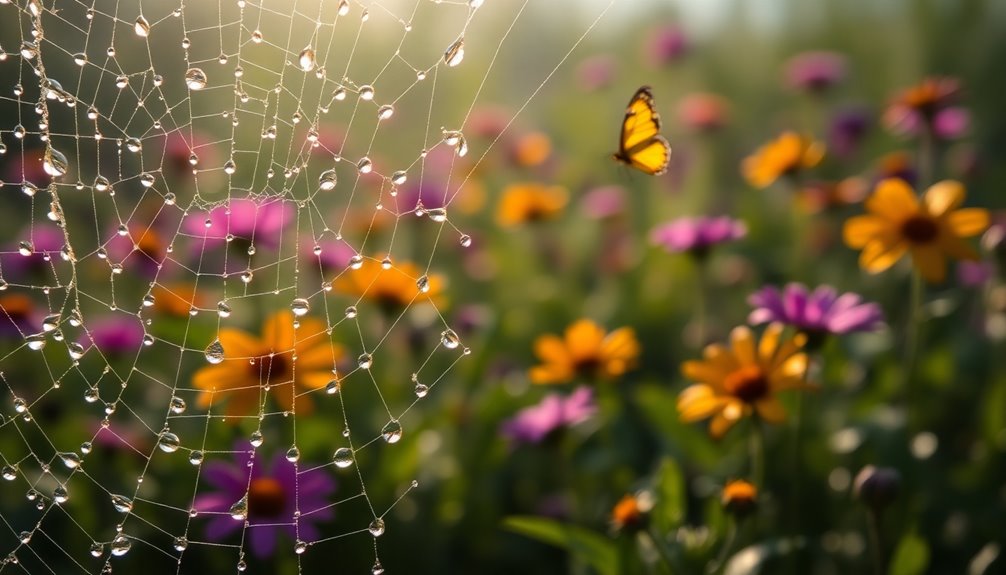
Nature serves as a profound medium for expressing human emotions and experiences in poetry. When you read a poem, think about how nature can symbolize feelings. For example, a storm might represent inner turmoil or conflict, while a gentle breeze could signify peace.
Poets like William Blake beautifully use natural elements to convey deep messages. He often portrays sunflowers, symbolizing humanity's weariness and the journey of life.
The changing seasons are also powerful symbols in poetry. Spring often represents rebirth and renewal, while winter might signify death or stagnation. Water, too, is a common natural symbol. It can represent life, purity, or transformation. In Virginia Woolf's work, water flows like existence, reminding us of life's ever-changing nature.
When poets weave natural imagery into their verses, they create strong emotional responses. You might feel joy, sadness, or even hope, connecting you to deeper themes and experiences.
Nature allows you to explore your feelings and understand the world around you. So, the next time you read a poem, pay attention to how nature plays a role in expressing emotions. It's a beautiful journey you won't want to miss!
Social Commentary Through Symbols
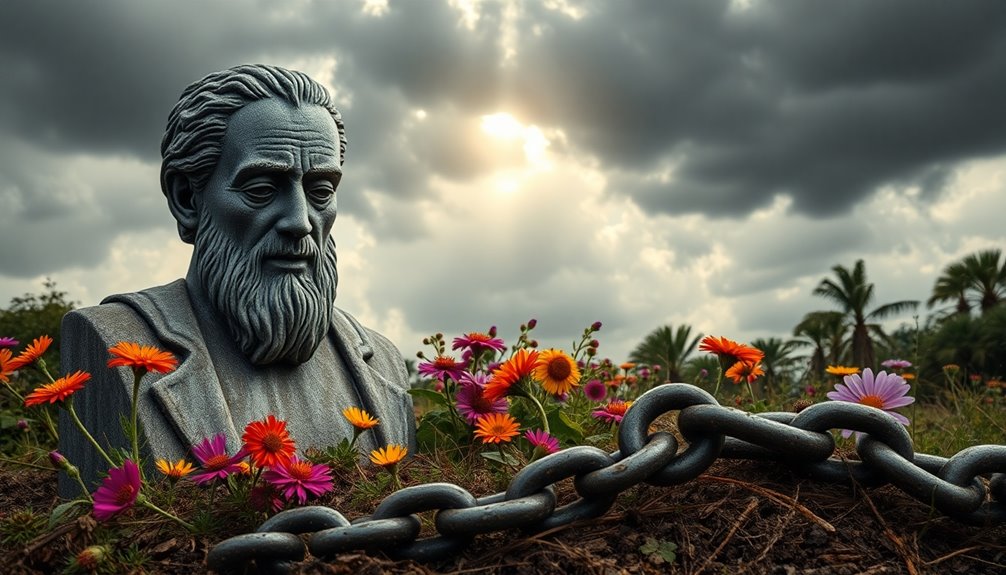
Symbols in poetry deliver powerful social commentary, enabling writers to critique societal issues without directly confronting them. Poets like William Blake masterfully use symbols to express deep thoughts about the world around them.
For example, he uses:
- Chimney sweepers to highlight child labor
- Palace walls as a symbol of death and oppressive power
- Chartered streets to show financial control over citizens
- Rivers that evoke feelings of economic exploitation
- The disparity between the ruling class and the working poor
These symbols invite you to think critically about society. Instead of saying, "child labor is wrong," Blake shows it through the eyes of innocent children. His use of symbols makes you feel and question the world.
Emotional Impact of Symbols

Symbols in poetry can really tug at your heartstrings!
They connect you to the emotions and experiences that the poet wants to share, making you feel like you're part of the story.
For instance, when you see a red rose, it might remind you of love and passion, sparking warm feelings inside.
Symbolism and Reader Emotion
In poetry, the emotional impact of symbols often serves as a bridge between the text and your personal experiences. When you encounter symbols, they can evoke specific emotions, making the poem feel alive and relatable.
Here are some ways symbols connect with your feelings:
- Nature symbols, like flowers, can represent love or loss.
- Seasons, such as winter, might reflect sadness or change.
- Colors can evoke joy, anger, or calmness.
- Objects, like a ring, may symbolize commitment or nostalgia.
- Animals often convey freedom or strength.
These symbols create a deeper bond between your feelings and the poem's themes. Your emotional response can change based on your unique experiences and culture. That's what makes poetry so special!
Poets use symbols to express complex feelings with just a few words. This invites you to think critically and reflect on the poem's meaning. By engaging with the symbolism, you explore intricate emotional landscapes, enhancing your understanding of the poem's depth.
Personal Resonance of Symbols
Throughout history, poets have harnessed the power of symbols to create a personal resonance that speaks directly to your emotions. When you read a poem, those symbols can spark strong emotional responses. They connect your own experiences with the broader themes the poet wants to share. For example, a beautiful sunset might remind you of a cherished memory, filling you with nostalgia or longing.
Poets often use symbols like nature and colors to help you explore complex feelings. Symbols allow you to dive deeper into themes like love, loss, and identity. Think about how a single flower can represent hope or a storm can symbolize conflict. These images can touch your heart in unique ways, making you think about your own life.
What's exciting is that the emotional impact of symbols can change based on your background or personal story. This means that everyone can find different meanings in the same poem!
Common Symbols and Their Meanings

Exploring common symbols in poetry reveals a rich tapestry of meanings that can deepen your understanding of a poem's emotional core.
These symbols often help you connect with the feelings and themes the poet wants to convey. Here are some common symbols and what they represent:
- Red Roses: These beautiful flowers symbolize love and romance, expressing deep affection and passion.
- Doves: Known for their gentle nature, doves represent peace and tranquility, bringing messages of harmony and hope.
- Skulls: A little darker, skulls remind us of mortality and the inevitability of death, highlighting life's fleeting moments.
- Keys: Often seen as symbols of access and freedom, keys represent new opportunities and the chance for discovery.
- Rainbows: After a storm, rainbows symbolize hope and promise, showing that beauty can follow adversity.
Frequently Asked Questions
What Is Symbolism and an Example?
Symbolism is when you use objects or images to represent bigger ideas or feelings. For example, a heart can symbolize love, making your writing more powerful and meaningful.
Think about how a rose often stands for beauty and romance. When you see a rose in a poem, it might make you feel warm and happy.
What Is an Example of a Symbol in Poetry?
One great example of a symbol in poetry is the red rose.
When you see a red rose, it often represents love and romance. Poets use this beautiful flower to express deep feelings for someone special.
When you read a poem with a red rose, it can make you think of love stories or special moments. This symbol helps create vivid images in your mind, making the emotions even more powerful and relatable!
What Is Symbolism as a Poetic Device?
Imagine walking through a garden, where every flower tells a story. That's what symbolism does in poetry! It uses symbols—like colors or objects—to express deeper meanings and emotions.
Instead of just saying something is happy, a poet might use a bright sun to show joy. This makes the poem more exciting and relatable.
Each symbol invites you to explore and discover your own interpretations, connecting you to the poem in a special way!
What Are 5 Examples of Symbolism in Sentences?
Here are five examples of symbolism.
In Wordsworth's poem, daffodils stand for joy and beauty in nature.
Dickinson uses light to show hope and renewal.
In Poe's "The Raven," the raven represents grief and loss.
Frost's diverging paths symbolize the choices we make in life.
Finally, in Hughes's poem, rivers connect to African American history and resilience.
Each symbol adds deeper meaning, making poetry even more exciting to explore!
Conclusion
So, next time you pick up a poem, keep an eye out for those hidden symbols! They're like secret messages waiting to be discovered. You might just find a tree that stands for life or a storm that reflects inner turmoil. Isn't that exciting? By unraveling these meanings, you open up a whole new world of feelings and ideas. Who knows what wonders await you in the lines of poetry? Immerse yourself and explore—adventure is just a word away!




